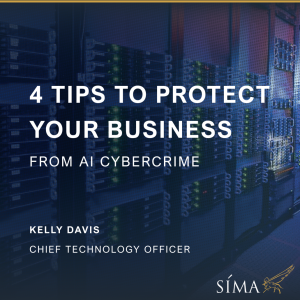 The rapid rise of artificial intelligence (AI) has dominated recent headlines. The ability to simulate the human cognitive process is a huge technological step forward with seemingly limitless potential. Businesses are rushing to take advantage of its ability to analyze massive amounts of data, automate responses, and streamline processes. However, this surge in popularity comes with significant concern about the lack of regulation and the substantial increase in AI-powered cybercrime. Cybercriminals are harnessing AI’s power to target victims more efficiently, attack faster, and create greater havoc.
The rapid rise of artificial intelligence (AI) has dominated recent headlines. The ability to simulate the human cognitive process is a huge technological step forward with seemingly limitless potential. Businesses are rushing to take advantage of its ability to analyze massive amounts of data, automate responses, and streamline processes. However, this surge in popularity comes with significant concern about the lack of regulation and the substantial increase in AI-powered cybercrime. Cybercriminals are harnessing AI’s power to target victims more efficiently, attack faster, and create greater havoc.
Small businesses are prime targets for AI attacks. It’s imperative for business owners and their teams to understand these risks and put a plan in place to protect their valuable data.
How Cybercriminals Exploit AI Technology:
- Automated Malware Generation: Cybercriminals use AI to automate the creation of sophisticated malware. AI-driven tools can quickly generate new variants of malware that adapt to traditional antivirus programs, hiding them from detection. This allows cybercriminals to stay ahead of conventional security measures.
- Advanced Phishing Attacks: AI-powered phishing attacks are becoming more and more convincing. Using AI to analyze massive datasets and craft highly personalized phishing emails, cybercriminals can more easily trick targets into clicking on malicious links or giving away sensitive information.
- Password Cracking: AI can significantly speed up the process of cracking passwords. AI algorithms perform brute-force attacks on password databases, allowing them to identify weak passwords more quickly and gain unauthorized access to accounts and networks.
- Automated Social Engineering: Cybercriminals use AI to analyze social media profiles and other publicly available data to gather information on potential targets. Using that information to craft convincing messages and build rapport, criminals can more easily exploit unwitting victims.
Tips to Protect Your Business Against Weaponized AI Technology:
- Monitor Your Network: Use network monitoring tools, such as intrusion detection systems (IDS), to detect suspicious activity like unauthorized access attempts and other unusual patterns of behavior. Catching an attack early can considerably reduce the damage it may cause.
- Cybersecurity Training and Awareness: Educate yourself and your employees about the risks of AI cybercrime. Conducting regular cybersecurity training can help employees prevent and respond quickly to threats. A well-informed team is a crucial line of defense against attacks.
- Cyber Hygiene and Strong Access Controls: Strong password policies, multi-factor authentication methods, and antivirus programs can go a long way in keeping your information safe. Limit access to and regularly back up sensitive information to reduce potential damage in case of a breach.
- Seek Professional Guidance: Your businesses may not have the in-house expertise or time capacity to handle advanced AI threats. Consider consulting with a cybersecurity professional or firm that specializes in providing cybersecurity services for small businesses. Email technology@simafg.com to set up a complimentary consultation with our IT experts.
While the future of artificial intelligence is unpredictable, there are concrete steps you can take to help secure your safety. By staying up to date on AI advancements and implementing proactive security measures, businesses can reduce the risk and minimize the damage of AI cybercrime.

Kelly Davis | Chief Technology Officer & President, SIMA Technology Group;
Other SIMA Technology posts:
Watch Out for Coronavirus Scams
Technology Outreach: Taking Employee Communication to the Next Level
2022 Year-End Technology Checklist
This content is not intended to be exhaustive, nor should it be viewed as legal or tax advice. Information presented is believed to be current and is provided for general information and educational purposes based upon publicly available information from sources believed to be reliable. We cannot assure the accuracy or completeness of this information. It is not intended as a thorough, in-depth analysis of specific issues, nor a substitute for a formal opinion, nor is it sufficient to avoid any penalties. You should always consult an attorney or tax professional regarding your specific legal or tax situation. This information may change at any time and without notice. SIMA reserves the right to edit blog entries and delete comments that contain offensive or inappropriate language.
